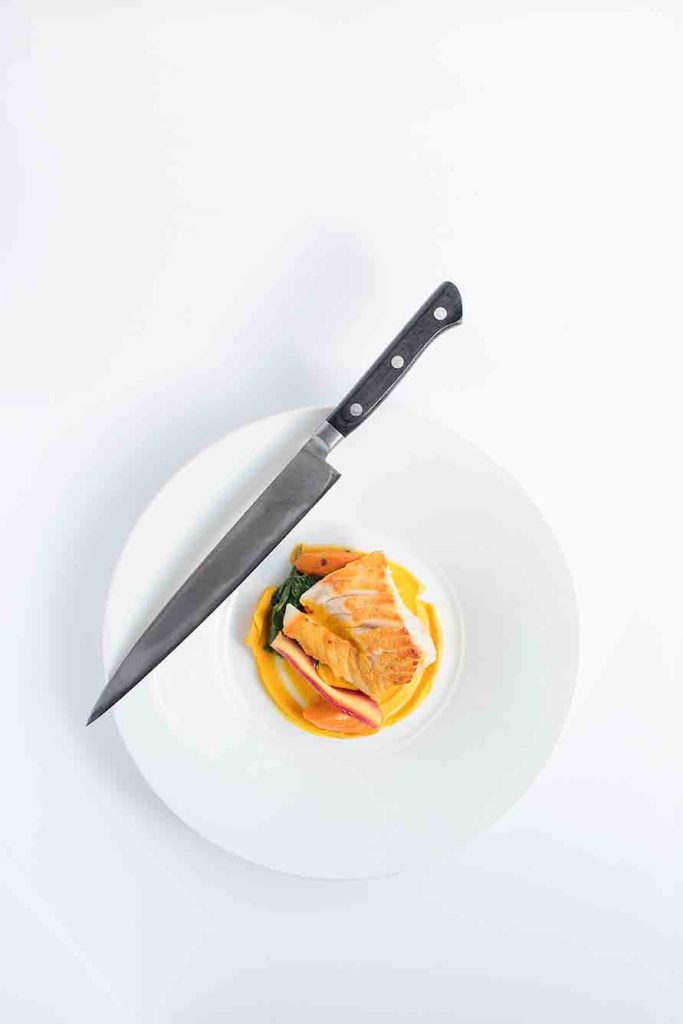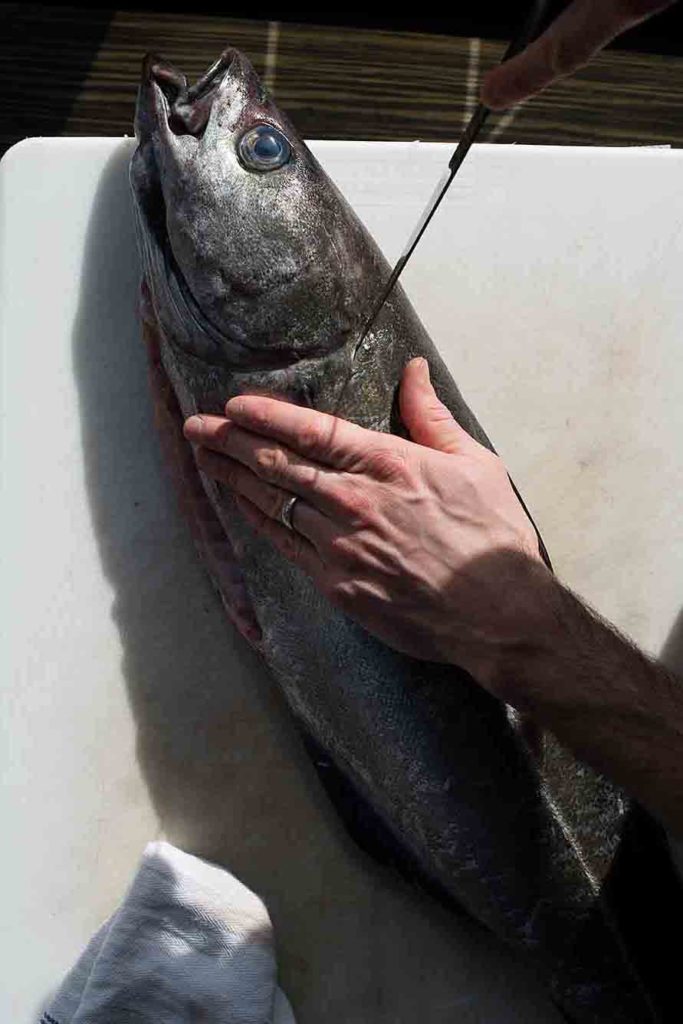Turning the Tide
By changing the way fishermen handle their catch, Gulf of Maine Sashimi is opening new markets for sustainable seafood

Jen Levin still remembers a conversation with a Maine fisherman she met about 15 years ago. He told her that the costs of his most recent fishing trip were more than what he made on the fish—a first for him. “Over the last 15 years I’ve heard that story many, many times from a lot of fishermen,” says Levin. “Clearly there’s been something wrong in our fisheries economics.” From the decidedly unglamorous headquarters of a new wholesale business on Portland’s Holyoke Wharf, Levin hopes to change this by introducing a new way that sustainable species of fish and seafood are harvested and handled.

Levin is the creator, president, and CEO of Gulf of Maine Sashimi, launched last year as a subsidiary of the Gulf of Maine Research Institute (GMRI), where she ran the nonprofit’s sustainable seafood program for just over a decade. The program’s ongoing goal is to make the region’s fisheries more profitable, in part by figuring out how fishermen can get higher prices for fish that are plentiful in the Gulf of Maine, such as redfish, pollock, haddock, whiting, monkfish, and mackerel. “These are species that are under-harvested, under-utilized, and under-loved,” says Levin. Last year, fishermen harvested 50 percent of the redfish quota and 9 percent of the pollock quota in the Gulf of Maine, and just 17 percent of the haddock quota of both the Gulf and Georges Bank, which is a shallow area between the Gulf of Maine at the Atlantic Ocean that was once one of the most productive fishing grounds in the world. “There are many reasons for their harvesting under these quotas, but one of the big ones is that fishermen are getting paid so little per pound that they cannot afford to harvest these fish,” she says.
In her tiny office down the hall from the two unheated, spotlessly clean rooms where fish are brought in, processed, and packed, Levin shares more sobering statistics. Ninety-one percent of the seafood we consume in the United States comes from outside the country—including Norway and Iceland, where the wild-caught quotas are far higher—and more than half of the fish and seafood we eat is farm raised.
“We realized that, even if our fishermen could meet their quotas, they were not going to be able to compete in terms of volume,” she says. “So, the question became, ‘How can we get into lower volume, higher value markets, such as high-end restaurants, where chefs are paying big bucks for imported fish?’”
A few years of research and testing later, Gulf of Maine Sashimi is answering the question. “We ultimately came to the understanding that you have to do things differently if you want to get paid more for your fish,” says Levin. She and her small team, Brendan Landry and Kelsey O’Connor, work with fishermen to instill new ways of handling fish on the boat, inspired by the Japanese practice of ikejime, which means to kill with purpose. By bringing the fish on board alive and killing them, rather than letting them die slowly on deck or in the net, “you actually end up with a chemically superior product because the fish isn’t releasing acids and other chemicals from stress into the meat,” Levin says. The product not only tastes better, but it also lasts longer.

Atlantic pollock with local carrots, cumin, and wilted greens prepared by chef Matt Ginn at Evo in Portland. 
Ginn’s roasted monkfish with fingerling potatoes from Two Farmers Farm in Scarborough, harissa, olives, and charred broccolini.
Matt Ginn, the chef of Evo in Portland, was an early Gulf of Maine Sashimi customer. “In 15 years of cooking, including fine dining in Boston, it is consistently the best fish I have ever seen or purchased,” says Ginn. “Let’s show people that these sustainable species are not inferior on the plate when they are handled properly; they are absolutely delicious.” While some customers may be skeptical when they see pollock or mackerel on the menu, Evo’s open kitchen allows for a dialogue, and Ginn’s reputation has established trust. “I tell people that pollock is in the same family as cod, haddock, and hake; cod was once abundant but now it’s not, so let’s eat something that is,” he says. Ginn also likes that he doesn’t know what fish Gulf of Maine Sashimi will have available. “As a chef it’s exciting that we can’t get the same fish every day,” he says. “I go to the farmers’ market all the time for the same reason.”
What fishermen catch varies due to the season, the weather, and the market, among other factors. Gulf of Maine Sashimi sources fish directly from as many as ten boats and maintains regular communications with fishermen out at sea. Landry, who is in charge of sourcing and sales, will often have a text exchange with a boat in the middle of the night and meet it to unload the catch at sunrise. As part of the onboard handling process, the fish are bled and immediately put into a saltwater-ice slurry. When they arrive at Holyoke Wharf, they are pristine, with clear eyes, firm flesh, and only the fresh, clean scent of the sea. “They take these extra steps and pride in their catch, and we guarantee them a premium price for that extra handling,” says Levin. At the Portland Fish Exchange, where the majority of Maine’s fish and seafood is purchased, redfish fetches 60 cents a pound. In contrast, Gulf of Maine Sashimi pays fishermen two dollars a pound. Fish are sold to customers whole or filleted, for those whose kitchens lack the space to break them down. O’Connor, a chef who worked for many years at David Turin’s restaurants, is in charge of product development and connects chefs with products such as cod roe. “We are trying to use as much of the fish as possible,” says Levin.

Ginn prepares to portion an Atlantic pollock. 
Ben Landry (in orange bibs) works to offload the catch from the F/V Nicole Leigh with crew member Hunter Prentice.
In just a few months, Gulf of Maine Sashimi fish has landed on menus at restaurants not only in Portland but also in Washington, D.C., Philadelphia, and New York City through a distributor partner, who is looking to expand to Florida and Las Vegas.
Locally, the company partners with Harbor Fish Market, which will make Gulf of Maine Sashimi fish available to customers who request it. “People might think that Harbor would be our competition, but no, we’re working together with the shared goal of contributing to the local seafood economy,” says Levin. Her longstanding relationships with chefs and other culinary partners through GMRI have been a significant advantage in reaching potential customers and advancing the new company’s mission. “I’m from Wisconsin, so I’m an outsider for sure, and that will never change,” says Levin. “But I’ve been around for long enough for people to know me and trust me. I not only know the fishermen, but also a lot of their wives, and I’ve seen their kids grow up. And I do bring a passion to this idea of, how can we resurrect a thriving fishing industry?” With every piece of whiting, monkfish, or pollock that makes it to a restaurant plate, she is helping to turn the tide in fishing’s favor.

